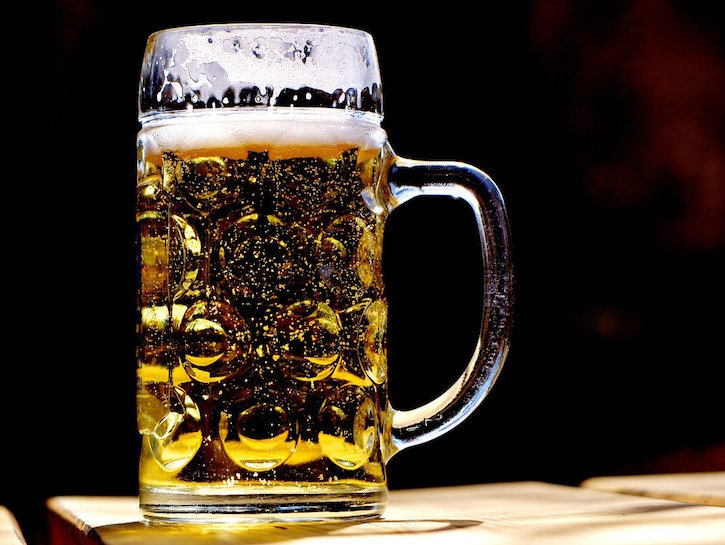When drinking beer, you need to know the basics. How bitter will it be? What’s the alcohol content? How many can you drink without falling over? This is where ABV and IBU come in. If you’re wondering about all the different beer colorings, refer to the SRM.
In short:
- ABV is an abbreviation for Alcohol By Volume and measures the percentage of alcohol in your beer.
- IBU is International Bitterness Units, which measures hop bitterness on a scale beginning at zero, with no cap.
- SRM is Standard Reference Method, a scale that classifies beers by color from pale straw to black.
What is ABV?
ABV stands for Alcohol By Volume and is important to pay attention to so you’re aware how much you are going to drink.
Unlike hard liquor, which is measured by proof, beer’s alcohol content is measured by ABV — the percentage of alcohol in your beer. For example, if you are drinking a 12-ounce bottle of beer that has a 5 percent ABV, that bottle has .6 ounces of pure alcohol. This standard of measurement is consistent worldwide.
The ABV typically falls somewhere between 2 percent and 12 percent, with the average ABV per volume falling between 4-6 percent.

NaturalBox/Shutterstock
What is IBU?
IBU stands for International Bitterness Units, which measures hop bitterness on a scale of that begins at 0 and has no cap. A beer’s level of bitterness relies on two factors during the brewing process: the roasted grains and hops, which are used in flavoring and when combined can make the beer more bitter, tangy or even fruity.
Hops contain alpha acids, which is where the bitter taste resides until released into the liquid during brewing. Generally, a beer that contains more hops will be more bitter. The hops also contain essential oils that impact a beer’s taste and aroma. These are added late in the brewing process and can make the beer more earthy or fruity in taste.
Typically, IPAs are the most bitter beers because they are so “hopped up.”

What is a session beer?
If you’re looking to enjoy drinking beer all afternoon, turn to a session beer. Session beers have a low alcohol content, low bitterness and are categorized by their drinkability. They are under 5 percent ABV, so you can partake in one or two without feeling the side effects of the alcohol. They’re a great choice for cracking open a cold one with the boys or grabbing a drink on your lunch break.

Pushish Images/Shutterstock
Why are some beers not bitter?
Not every beer is bitter, even if it contains hops. There are three main ingredients in beer — hops, barley and yeast — and all work together to produce each drink’s unique taste. Yeasts make the beer more fruity in taste and barley produces grainy flavors. Barley that has been prepared specifically for brewing beer is commonly known as “malt.”
Hop bitterness depends on alpha acid content, how long the hops are boiled, the amount of hops used and the balance between hops and malts. In general, the more hops you add, the more flavorful and bitter the beer will be. Conversely, the beer’s roasted grains are sweeter, which can subdue the bitter hop flavor.
If you’re looking for a beer that isn’t bitter, try porters, wheat beers or saisons.

Viacheslav Rubel/Shutterstock
What is SRM?
The SRM, or Standard Reference Method, is a scale that classifies beers by color from pale straw (a 2 on the SRM scale) to black (a 40 on the scale). The darker the color, the higher the SRM number. Therefore, wheat beers and light lagers are the lowest on the scale and stouts are the highest.
Each type of beer has a range it falls into on the SRM scale. Typically, each beer falls on the scale from lightest to darkest as such:
- 2 — Pale Lager, Pilsner, Witbier, Berliner Weisse
- 3 — Maibock, Blonde Ale
- 4 — Weissbier
- 6 — American Pale Ale, Indian Pale Ale
- 8 — Saison
- 10 — English Bitter
- 13 — Biere de Garde, Double IPA
- 17 — Dark Lager, Amber Ale, Märzen, Vienna Lager
- 20 — Brown Ale, Bock, Dunkel
- 24 — Irish Dry Stout, Dopplebock, Porter
- 29 — Stout
- 35 — Foreign Stout, Baltic Porter
- 40 — Imperial Stout
However, it is important to remember that color is not equivalent to flavor, so a darker beer won’t always be more bitter than a lighter beer or vice versa.

Irmelamela/Shutterstock
